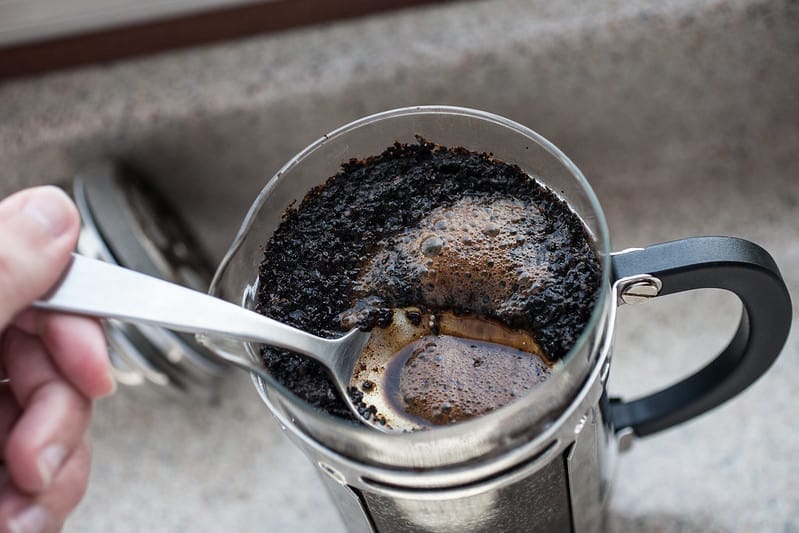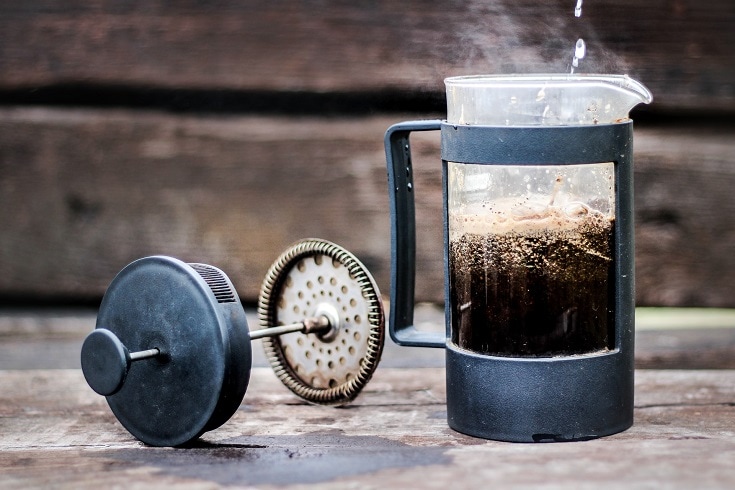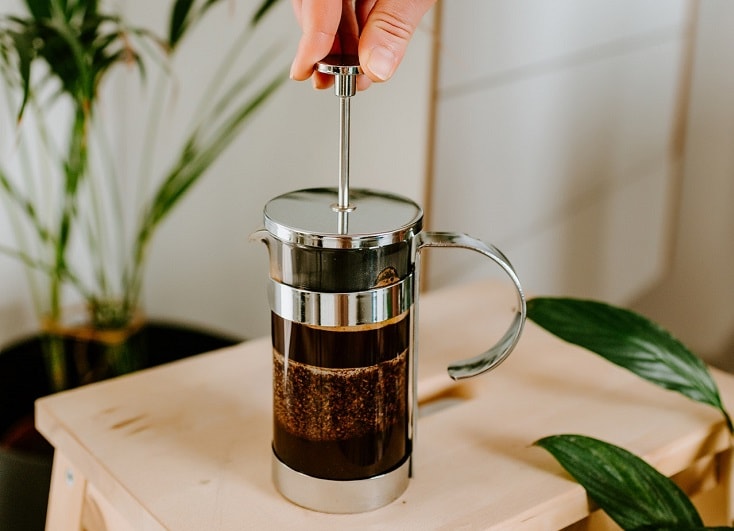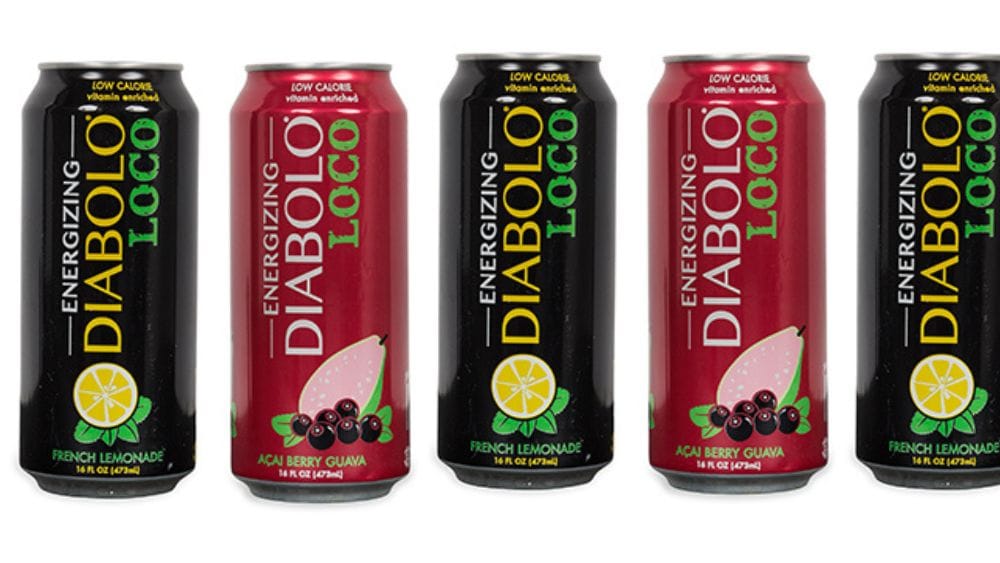
Immersion coffee brewing is, in our opinion, the purest way to make coffee. It doesn’t require anything besides coffee and water, and you don’t need a pressure pump, paper filter, or any other gadgets or doohickeys. Simply soak ground coffee in water for a few minutes, and voila, you have a delicious cup of coffee. Of course, it is much easier in practice to use a French press, for example, so that you don’t have to fish out the coffee grounds by hand, but that is a matter of convenience and doesn’t change the taste at all.
In this article, we’re going to give you an overview of immersion brewing, covering what makes it so popular and how it works before concluding with a breakdown of our favorite specific immersion brew methods. If you want to learn the ins and outs of immersion brewing, you’ve come to the right place.

What is Immersion Coffee Brewing?
You might hazard a guess from the name that immersion brewing requires ground coffee to sit in water, and you would be right. All you technically have to do to brew coffee by immersion is fill a bowl with water, dump in some ground coffee, and stir.
Immersion brewing isn’t the only way to brew coffee. Another popular and widespread brewing style is percolation. Old school percolators and stovetop Moka pots fall under the umbrella of percolation brewing. There are also drip methods, like modern automatic drip machines and manual pour-overs. Even though this guide is all about immersion brewing, it will help compare and contrast immersion, drip, and percolation brewing to gain a deeper understanding of the immersion method.

Benefits of Immersion Brewing
It’s Easy
In our opinion, the number one benefit of immersion brewing is how easy it is to do. There are no techniques to master and very little that you need to do to make great tasting coffee. As long as you are using properly sized coffee grounds and have the right coffee to water ratio (more on this soon), your coffee will come out great.
Contrast this with a manual pour-over, and the difference is stark. Pour-over coffee is one of the most notoriously difficult brew methods to master, and some people don’t have the desire to spend days or weeks tweaking things to get their coffee to taste right. Immersion brewing methods don’t have this problem, and it’s easy to start making excellent coffee from your first brew.
It’s Scalable
Countertop coffee makers and manual pour-overs are usually limited to making small batches. Percolation and drip brewing don’t work well unless you use the appropriate amount of coffee that matches your brewer’s capacity. Water flow changes as you change how much coffee you use, meaning larger batches will taste different than smaller ones.
Immersion brewers, on the other hand, entirely avoid this problem. You can make as large or small a batch as you need to; all that matters is the relative amounts of coffee and water.

It Tastes Great
Just because immersion brewing is easier to get right than other methods doesn’t mean it’s inferior. Immersion brewing tends to accentuate a bean’s natural sweetness and enhance chocolatey, earthy-tasting notes. Most people find these flavors very appealing, which is one reason immersion brewing is so popular.
Percolated and drip coffee also tastes great, but it often brings out different flavors that some people aren’t as fond of, typically citrusy, fruity flavors. Pour-over, in particular, is more of an acquired taste than French press coffee.

General Immersion Brewing Tips
Before we talk about specific immersion brewing methods, let’s talk about general tips that apply to all immersion-style brewers.
Grind Size
When you make coffee with an immersion brewer, you generally want to use a fairly coarse grind size. If you grind too finely or use pre-ground coffee meant for automatic drip machines, you’ll struggle to make coffee that isn’t overly bitter and astringent.
This is the most important tip for making tasty immersion coffee, so make sure you buy whole-bean coffee and grind it yourself at home. If you don’t have a coffee grinder, look for a store that has a public grinder you can use and grind the beans on a coarse setting when you buy them. Some brands even sell pre-ground coffee that is coarser than normal and usually labeled as “ground for French press.”

Coffee-to-Water ratio
How much coffee you use relative to the amount of water is extremely important for all brewing methods, including immersion brewing. We recommend experimenting with between 1:15 and 1:17 coffee-to-water ratios and sticking with what you like best. Our personal preference is usually around 1:15 for immersion brewing, but tastes differ, and many people prefer 1:16. The only way to know for sure what you like best is to try a variety of ratios yourself.
The best way to make sure you get the ratio right is with a kitchen scale. Weighing the coffee beans and water is the easiest way to get consistency and is better than using a measuring cup. When you measure by volume – as you do with a measuring cup – rather than by weight with a scale, it’s hard to compare recipes that use different coffee beans. Not all coffee beans are the same size, and this could throw off future brews when you try to use the same recipe with different beans.
RELATED READ: Try our simple Coffee to Water Ratio Calculator!

Immersion Brewing Methods
Now that you have a general view of immersion brewing, let’s discuss our two favorite specific immersion brewing methods.
French Press
We have a soft spot for French press coffee since it was our introduction to making better coffee. When all we knew was grocery store coffee brewed in an automatic drip machine, our first foray into using a French press was eye-opening. The depth of richness and texture you can get with a French press is unparalleled, and we still make French press coffee regularly even as we branch out and experiment with new brew methods.
- Use a 1:15 coffee-to-water ratio by weight. For one cup, use 20 g of coffee and 300 g of water.
- Boil the water.
- While the water is boiling, grind your coffee beans in a coarse setting.
- Once the water has boiled, start a timer, and pour 300 g of water over the ground coffee. Wait for one minute.
- When the timer reaches 1 minute, gently stir the coffee-water mixture, ensuring that all of the grounds are in contact with the water. Let the coffee sit for 4 minutes.
- After 4 minutes, gently press the plunger on the French press until it almost reaches the bottom. Be careful not to compress the coffee grounds on the bottom of the French press. Squeezing the grounds will cause your coffee to taste bitter and harsh.

Cold Brew
Cold brew coffee is the quintessential example of an immersion-style brew. It’s similar to French press coffee but tastes sweeter and has a smooth, velvety texture. Cold brew coffee is less acidic than traditional, hot-brewed coffee, so it’s perfect for people who can’t drink regular coffee for health reasons.
Our favorite cold brew recipe makes a cold brew concentrate, which you can either drink straight or diluted in a 1:1 ratio with water, ice, or milk. A major benefit of making a concentrate with such a high coffee to water ratio is you can keep it in your refrigerator for up to a week without it going bad or losing flavor. We like to use a French press for cold brew, but you can use any filtration mechanism you like, including a regular mesh kitchen strainer. We’ll write the recipe assuming you’ll be using a French press.
- Use a scale to measure coffee and water in a 1:7 coffee-to-water ratio. This makes very concentrated coffee, but it’s so smooth that it’s still delicious.
- Grind the coffee extremely coarsely, even coarser than you would use for a regular, hot French press.
- Add the coffee and water to your French press.
- Stir until all the grounds are saturated.
- Leave the cold brew to sit for 16 hours at room temperature.
- After 16 hours have elapsed, plunge the coffee and decant it into a separate carafe.
- Serve straight or over ice, and enjoy!

Conclusion
We love immersion brewing, and this article barely scratches the surface of what you can do with it. Hopefully, you found this introductory guide helpful and have a better idea of what immersion brewing is and how to make delicious coffee with an immersion brewer. French press and cold brew aren’t the only immersion brewers out there – not by a long shot – but they are two of the most popular and easiest to use.
If you’re a long-time percolation drinker, immersion brewing is a completely different experience that is definitely worth taking for a test drive. Whether you’re looking for something new to liven up your coffee routine, or are just curious, give immersion brewing a try!
RELATED READS:
- How to Make Decaf Cold Brew Coffee (Simple Steps)
- 20 Coffee Brewing Methods & Their Differences (With Pictures)
- How to Make Espresso in a French Press
Featured Image: Joseph Robertson, Flickr CC 2.0















